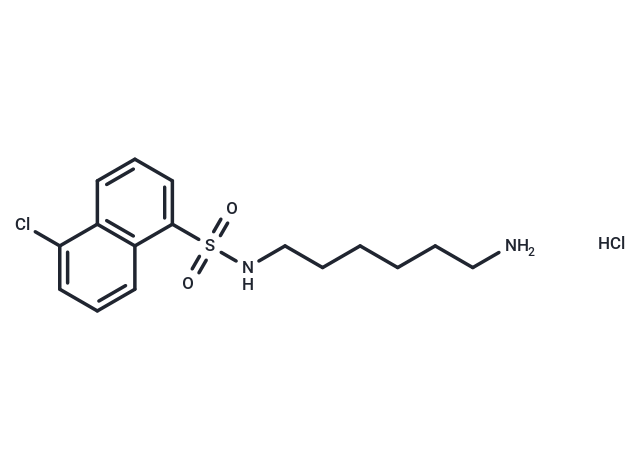Shopping Cart
- Remove All
 Your shopping cart is currently empty
Your shopping cart is currently empty

W-7 hydrochloride (W-7 HCl), a calmodulin antagonist, inhibits Ca2+-calmodulin-dependent myosin light chain kinase and phosphodiesterase, W-7 hydrochloride induces apoptosis and has antitumor activity.

| Pack Size | Price | Availability | Quantity |
|---|---|---|---|
| 10 mg | $30 | In Stock | |
| 25 mg | $64 | In Stock | |
| 50 mg | Preferential | In Stock | |
| 1 mL x 10 mM (in DMSO) | $29 | In Stock |
| Description | W-7 hydrochloride (W-7 HCl), a calmodulin antagonist, inhibits Ca2+-calmodulin-dependent myosin light chain kinase and phosphodiesterase, W-7 hydrochloride induces apoptosis and has antitumor activity. |
| Targets&IC50 | Myosin light chain kinase:51 µM (IC50), PDE:28 μM (IC50) |
| Alias | W-7 HCl, W7 HCl, W 7 HCl |
| Molecular Weight | 377.32 |
| Formula | C16H22Cl2N2O2S |
| Cas No. | 61714-27-0 |
| Smiles | C1=CC2=C(C=CC=C2Cl)C(=C1)S(=O)(=O)NCCCCCCN.Cl |
| Relative Density. | no data available |
| Storage | store at low temperature | Powder: -20°C for 3 years | In solvent: -80°C for 1 year | Shipping with blue ice. | |||||||||||||||||||||||||||||||||||
| Solubility Information | DMSO: 250 mg/mL (662.55 mM), Sonication is recommended. | |||||||||||||||||||||||||||||||||||
Solution Preparation Table | ||||||||||||||||||||||||||||||||||||
DMSO
| ||||||||||||||||||||||||||||||||||||

Copyright © 2015-2025 TargetMol Chemicals Inc. All Rights Reserved.